7.3 How We Remember: Cues to Improving Memory
Learning Objectives
- Label and review the principles of encoding, storage, and retrieval.
- Describe how the context in which we learn information can influence our memory of that information.
Although it is useful to hold information in sensory and short-term memory, we also rely on our long-term memory (LTM). We want to remember the name of the new boy in the class, the name of the movie we saw last week, and the material for our upcoming psychology test. Psychological research has produced a great deal of knowledge about long-term memory, and this research can be useful as you try to learn and remember new material (see Table 7.2). In this section we will consider this question in terms of the types of processing that we do on the information we want to remember. To be successful, the information that we want to remember must be encoded and stored, and then retrieved.
| Technique | Description | Useful example |
|---|---|---|
| Use elaborative encoding. | Material is better remembered if it is processed more fully. | Think, for instance, “Proactive interference is like retroactive interference but it occurs in a forward manner.” |
| Make use of the self-reference effect. | Material is better remembered if it is linked to thoughts about the self. | Think, for instance, “I remember a time when I knew the answer to an exam question but couldn’t quite get it to come to mind. This was an example of the tip-of-the-tongue phenomenon.” |
| Be aware of the forgetting curve. | Information that we have learned drops off rapidly with time. | Review the material that you have already studied right before the exam to increase the likelihood it will remain in memory. |
| Make use of the spacing effect. | Information is learned better when it is studied in shorter periods spaced over time. | Study a little bit every day; do not cram at the last minute. |
| Rely on overlearning. | We can continue to learn even after we think we know the information perfectly. | Keep studying, even if you think you already have it down. |
| Use context-dependent retrieval. | We have better retrieval when it occurs in the same situation in which we learned the material. | If possible, study under conditions similar to the conditions in which you will take the exam. |
| Use state-dependent retrieval. | We have better retrieval when we are in the same psychological state as we were when we learned the material. | Many possibilities, but don’t study under the influence of drugs or alcohol, unless you plan to use them on the day of the exam (which is not recommended). |
Table 7.2
Encoding and Storage: How Our Perceptions Become Memories
Encoding is the process by which we place the things that we experience into memory. Unless information is encoded, it cannot be remembered. I’m sure you’ve been to a party where you’ve been introduced to someone and then—maybe only seconds later—you realize that you do not remember the person’s name. Of course it’s not really surprising that you can’t remember the name, because you probably were distracted and you never encoded the name to begin with.
Not everything we experience can or should be encoded. We tend to encode things that we need to remember and not bother to encode things that are irrelevant. Look at Figure 8.8, which shows different images of U.S. pennies. Can you tell which one is the real one? Nickerson and Adams (1979) found that very few of the U.S. participants they tested could identify the right one. We see pennies a lot, but we don’t bother to encode their features.

One way to improve our memory is to use better encoding strategies. Some ways of studying are more effective than others. Research has found that we are better able to remember information if we encode it in a meaningful way. When we engage in elaborative encoding we process new information in ways that make it more relevant or meaningful (Craik & Lockhart, 1972; Harris & Qualls, 2000).
Imagine that you are trying to remember the characteristics of the different schools of psychology we discussed in Chapter 1 “Overview of the Nervous System.” Rather than simply trying to remember the parts of the brain and their associated behaviors, you might try to relate the information to things you already know. For example, you might associate temporal with tempo and beats which reminds you of music which you hear. You might also try to organize the information into meaningful units. You also might try to use visual cues to help you remember the information. For instance, you might try to remember the the temporal lobe is important in understanding sounds by relating it to its position close to the ear. Each person has his or her unique way of elaborating on information; the important thing is to try to develop unique and meaningful associations among the materials.
Examples: Research Focus: Elaboration and Memory
In an important study showing the effectiveness of elaborative encoding, Rogers, Kuiper, and Kirker (1977) studied how people recalled information that they had learned under different processing conditions. All the participants were presented with the same list of 40 adjectives to learn, but through the use of random assignment, the participants were given one of four different sets of instructions about how to process the adjectives.
Participants assigned to the structural task condition were asked to judge whether the word was printed in uppercase or lowercase letters. Participants in the phonemic task condition were asked whether or not the word rhymed with another given word. In the semantic task condition, the participants were asked if the word was a synonym of another word. And in the self-reference task condition, participants were asked to indicate whether or not the given adjective was or was not true of themselves. After completing the specified task, each participant was asked to recall as many adjectives as he or she could remember.
Rogers and his colleagues hypothesized that different types of processing would have different effects on memory. As you can see in Figure 7.6”, the students in the self-reference task condition recalled significantly more adjectives than did students in any other condition. This finding, known as the self-reference effect, is powerful evidence that the self-concept helps us organize and remember information. The next time you are studying for an exam, you might try relating the material to your own experiences. The self-reference effect suggests that doing so will help you better remember the information (Symons & Johnson, 1997).
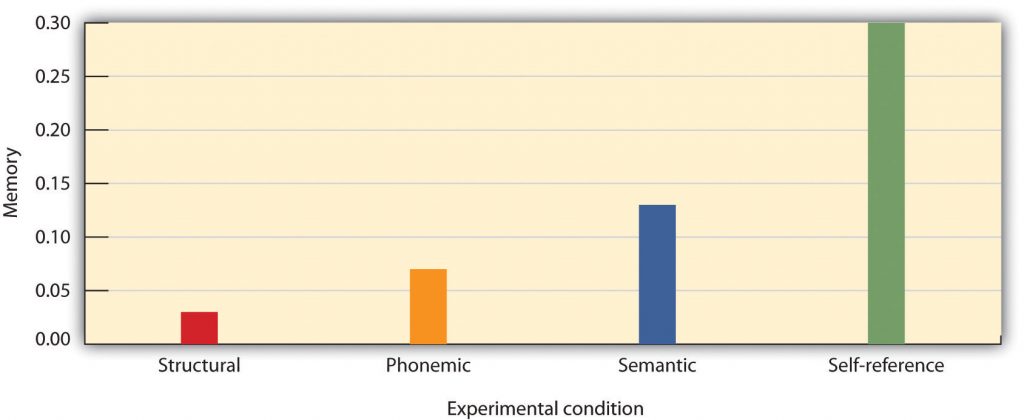
Using the Contributions of Hermann Ebbinghaus to Improve Your Memory
Hermann Ebbinghaus (1850–1909) was a pioneer of the study of memory. In this section we consider three of his most important findings, each of which can help you improve your memory. In his research, in which he was the only research participant, Ebbinghaus practiced memorizing lists of nonsense syllables, such as the following:
DIF, LAJ, LEQ, MUV, WYC, DAL, SEN, KEP, NUD
You can imagine that because the material that he was trying to learn was not at all meaningful, it was not easy to do. Ebbinghaus plotted how many of the syllables he could remember against the time that had elapsed since he had studied them. He discovered an important principle of memory: Memory decays rapidly at first, but the amount of decay levels off with time (Figure 7.8). Although Ebbinghaus looked at forgetting after days had elapsed, the same effect occurs on longer and shorter time scales. Bahrick (1984) found that students who took a Spanish language course forgot about one half of the vocabulary that they had learned within three years, but that after that time their memory remained pretty much constant. Forgetting also drops off quickly on a shorter time frame. This suggests that you should try to review the material that you have already studied right before you take an exam; that way, you will be more likely to remember the material during the exam.
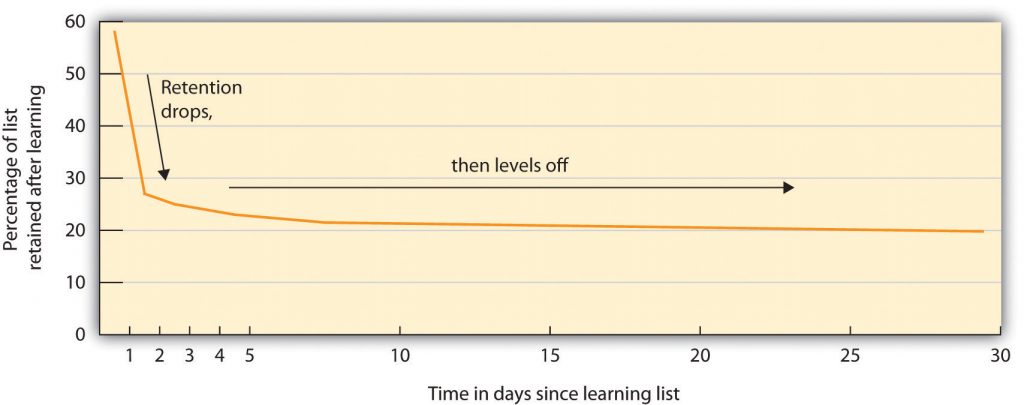
Ebbinghaus also discovered another important principle of learning, known as the spacing effect. The spacing effect refers to the fact that learning is better when the same amount of study is spread out over periods of time than it is when it occurs closer together or at the same time. This means that even if you have only a limited amount of time to study, you’ll learn more if you study continually throughout the semester (a little bit every day is best) than if you wait to cram at the last minute before your exam (Figure 7.8). Another good strategy is to study and then wait as long as you can before you forget the material. Then review the information and again wait as long as you can before you forget it. (This probably will be a longer period of time than the first time.) Repeat and repeat again. The spacing effect is usually considered in terms of the difference between distributed practice (practice that is spread out over time) and massed practice(practice that comes in one block), with the former approach producing better memory.
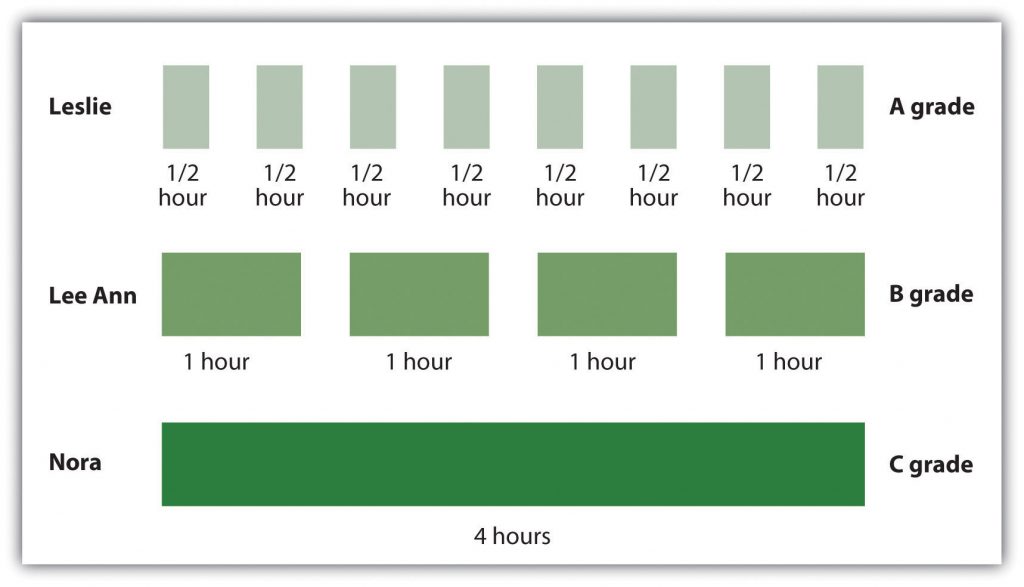
Ebbinghaus also considered the role of overlearning—that is, continuing to practice and study even when we think that we have mastered the material. Ebbinghaus and other researchers have found that overlearning helps encoding (Driskell, Willis, & Copper, 1992). Students frequently think that they have already mastered the material but then discover when they get to the exam that they have not. The point is clear: Try to keep studying and reviewing, even if you think you already know all the material.
Retrieval
Even when information has been adequately encoded and stored, it does not do us any good if we cannot retrieve it. Retrieval refers to the process of reactivating information that has been stored in memory. Try the Cued Retrieval exercise below to better understand how categories can help us remember better.
Exercise: Cued Retrieval
You can get an idea of the difficulty posed by retrieval by simply reading each of the words (but not the categories) below to someone. Tell the person that after you have read all the words, you will ask her to recall the words. After you read the list to your friend, give her enough time to write down all the words that she can recall. Make sure that she cannot recall any more and then, for the words that were not listed, prompt your friend with some of the category names: “Do you remember any words that were furniture? Do you remember any words that were tools?” I think you will find that the category names, which serve as retrieval cues, will help your friend remember information that she could not retrieve otherwise.
| Apple | (Fruit) |
| Dresser | (Furniture) |
| Sander | (Tool) |
| Pomegranate | (Fruit) |
| Sunflower | (Flower) |
| Tangerine | (Fruit) |
| Chair | (Furniture) |
| Peony | (Flower) |
| Banana | (Fruit) |
| Sofa | (Furniture) |
| Bench | (Furniture) |
| Strawberry | (Fruit) |
| Television stand | (Furniture) |
| Magnolia | (Flower) |
| Rose | (Flower) |
| Wrench | (Tool) |
| Screwdriver | (Tool) |
| Dahlia | (Flower) |
| Drill press | (Tool) |
| Hammer | (Tool) |
We’ve all experienced retrieval failure in the form of the frustrating tip-of-the-tongue phenomenon, in which we are certain that we know something that we are trying to recall but cannot quite come up with it. Try the Tip-of-the-tongue Phenomenon Exercise below. You’ll probably find that having the first letters of the cities helps with retrieval. The tip-of-the-tongue experience is a very good example of the inability to retrieve information that is actually stored in memory.
Exercise: Tip-of-the-tongue Phenomenon
Try this demonstration of the tip-of-the-tongue phenomenon with a classmate. Read your friend the names of the 10 states listed in the sidebar below, and ask him to name the capital city of each state. Now, for the capital cities that your friend can’t name, give him just the first letter of the capital city.
| Georgia | (Atlanta) |
| Maryland | (Annapolis) |
| California | (Sacramento) |
| Louisiana | (Baton Rouge) |
| Florida | (Tallahassee) |
| Colorado | (Denver) |
| New Jersey | (Trenton) |
| Arizona | (Phoenix) |
| Nebraska | (Lincoln) |
| Kentucky | (Frankfort) |
We are more likely to be able to retrieve items from memory when conditions at retrieval are similar to the conditions under which we encoded them. Context-dependent learning refers to an increase in retrieval when the external situation in which information is learned matches the situation in which it is remembered. Godden and Baddeley (1975) conducted a study to test this idea using scuba divers. They asked the divers to learn a list of words either when they were on land or when they were underwater. Then they tested the divers on their memory, either in the same or the opposite situation. As you can see in Figure 7.9, the divers’ memory was better when they were tested in the same context in which they had learned the words than when they were tested in the other context.
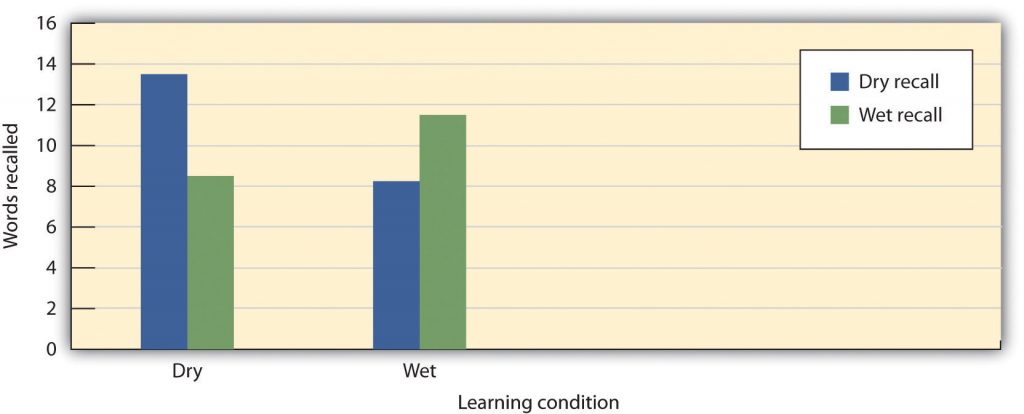
You can see that context-dependent learning might also be important in improving your memory. For instance, you might want to try to study for an exam in a situation that is similar to the one in which you are going to take the exam.
Whereas context-dependent learning refers to a match in the external situation between learning and remembering, state-dependent learning refers to superior retrieval of memories when the individual is in the same physiological or psychological state as during encoding. Research has found, for instance, that animals that learn a maze while under the influence of one drug tend to remember their learning better when they are tested under the influence of the same drug than when they are tested without the drug (Jackson, Koek, & Colpaert, 1992). And research with humans finds that bilinguals remember better when tested in the same language in which they learned the material (Marian & Kaushanskaya, 2007). Mood states may also produce state-dependent learning. People who learn information when they are in a bad (rather than a good) mood find it easier to recall these memories when they are tested while they are in a bad mood, and vice versa. It is easier to recall unpleasant memories than pleasant ones when we’re sad, and easier to recall pleasant memories than unpleasant ones when we’re happy (Bower, 1981; Eich, 2008).
Variations in the ability to retrieve information are also seen in the serial position curve. When we give people a list of words one at a time (e.g., on flashcards) and then ask them to recall them, the results look something like those in Figure 7.10. People are able to retrieve more words that were presented to them at the beginning and the end of the list than they are words that were presented in the middle of the list. This pattern, known as the serial position curve, is caused by two retrieval phenomenon: The primacy effect refers to a tendency to better remember stimuli that are presented early in a list. The recency effect refers to the tendency to better remember stimuli that are presented later in a list.
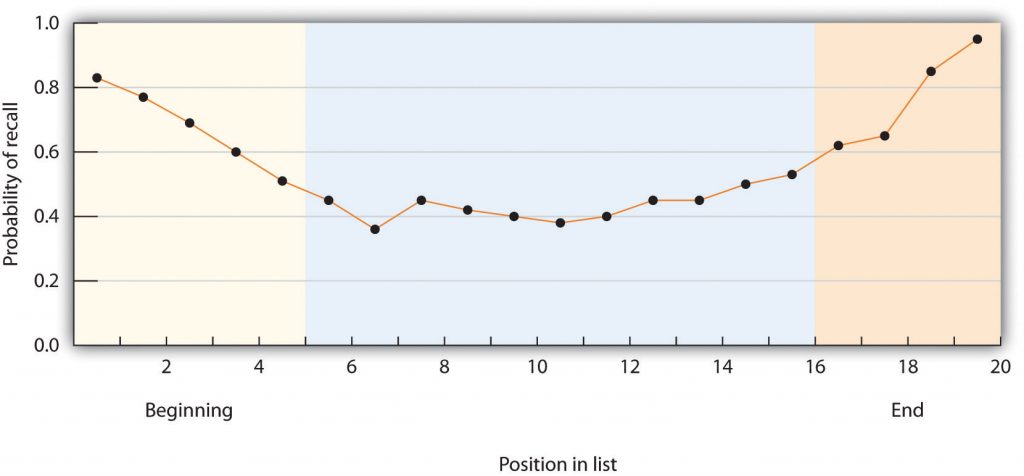
There are a number of explanations for primacy and recency effects, but one of them is in terms of the effects of rehearsal on short-term and long-term memory (Baddeley, Eysenck, & Anderson, 2009). Because we can keep the last words that we learned in the presented list in short-term memory by rehearsing them before the memory test begins, they are relatively easily remembered. So the recency effect can be explained in terms of maintenance rehearsal in short-term memory. And the primacy effect may also be due to rehearsal—when we hear the first word in the list we start to rehearse it, making it more likely that it will be moved from short-term to long-term memory. And the same is true for the other words that come early in the list. But for the words in the middle of the list, this rehearsal becomes much harder, making them less likely to be moved to LTM.
In some cases our existing memories influence our new learning. This may occur either in a backward way or a forward way. Retroactive interference occurs when learning something new impairs our ability to retrieve information that was learned earlier. For example, if you have learned to program in one computer language, and then you learn to program in another similar one, you may start to make mistakes programming the first language that you never would have made before you learned the new one. In this case the new memories work backward (retroactively) to influence retrieval from memory that is already in place.
In contrast to retroactive interference, proactive interference works in a forward direction. Proactive interference occurs when earlier learning impairs our ability to encode information that we try to learn later. For example, if we have learned French as a second language, this knowledge may make it more difficult, at least in some respects, to learn a third language (say Spanish), which involves similar but not identical vocabulary.
The Structure of LTM: Categories, Prototypes, and Schemas
Memories that are stored in LTM are not isolated but rather are linked together into categories—networks of associated memories that have features in common with each other. Forming categories, and using categories to guide behavior, is a fundamental part of human nature. Associated concepts within a category are connected through spreading activation, which occurs when activating one element of a category activates other associated elements. For instance, because tools are associated in a category, reminding people of the word “screwdriver” will help them remember the word “wrench.” And, when people have learned lists of words that come from different categories (e.g., as in Note 8.33), they do not recall the information haphazardly. If they have just remembered the word “wrench,” they are more likely to remember the word “screwdriver” next than they are to remember the word “dahlia,” because the words are organized in memory by category and because “dahlia” is activated by spreading activation from “wrench” (Srull & Wyer, 1989).
Some categories have defining features that must be true of all members of the category. For instance, all members of the category “triangles” have three sides, and all members of the category “birds” lay eggs. But most categories are not so well-defined; the members of the category share some common features, but it is impossible to define which are or are not members of the category. For instance, there is no clear definition of the category “tool.” Some examples of the category, such as a hammer and a wrench, are clearly and easily identified as category members, whereas other members are not so obvious. Is an ironing board a tool? What about a car?
Members of categories (even those with defining features) can be compared to the category prototype, which is the member of the category that is most average or typical of the category. Some category members are more prototypical of, or similar to, the category than others. For instance, some category members (robins and sparrows) are highly prototypical of the category “birds,” whereas other category members (penguins and ostriches) are less prototypical. We retrieve information that is prototypical of a category faster than we retrieve information that is less prototypical (Rosch, 1975).
Mental categories are sometimes referred to as schemas—patterns of knowledge in long-term memory that help us organize information. We have schemas about objects (that a triangle has three sides and may take on different angles), about people (that Sam is friendly, likes to golf, and always wears sandals), about events (the particular steps involved in ordering a meal at a restaurant), and about social groups (we call these group schemas stereotypes).
Schemas are important in part because they help us remember new information by providing an organizational structure for it. Read the following paragraph (Bransford & Johnson, 1972) and then try to write down everything you can remember.
The procedure is actually quite simple. First you arrange things into different groups. Of course, one pile may be sufficient depending on how much there is to do. If you have to go somewhere else due to lack of facilities, that is the next step; otherwise you are pretty well set. It is important not to overdo things. That is, it is better to do too few things at once than too many. In the short run this may not seem important, but complications can easily arise. A mistake can be expensive as well. At first the whole procedure will seem complicated. Soon, however, it will become just another facet of life. It is difficult to foresee any end to the necessity for this task in the immediate future, but then one never can tell. After the procedure is completed, one arranges the materials into different groups again. Then they can be put into their appropriate places. Eventually they will be used once more and the whole cycle will then have to be repeated. However, that is part of life.
It turns out that people’s memory for this information is quite poor, unless they have been told ahead of time that the information describes “doing the laundry,” in which case their memory for the material is much better. This demonstration of the role of schemas in memory shows how our existing knowledge can help us organize new information, and how this organization can improve encoding, storage, and retrieval.
Key Takeaways
- Information is better remembered when it is meaningfully elaborated.
- Hermann Ebbinghaus made important contributions to the study of learning, including modeling the forgetting curve, and studying the spacing effect and the benefits of overlearning.
- Context- and state-dependent learning, as well as primacy and recency effects, influence long-term memory.
Exercises and Critical Thinking
- Plan a course of action to help you study for your next exam, incorporating as many of the techniques mentioned in this section as possible. Try to implement the plan.
- Make a list of some the schemas that you have stored in your memory. What are the contents of each schema, and how might you use the schema to help you remember new information?
References
learning is better when the same amount of study is spread out over periods of time than it is when it occurs closer together or at the same time
practice that is spread out over time
practice that comes in one block
continuing to practice and study even when we think that we have mastered the material
the process of reactivating information that has been stored in memory
an increase in retrieval when the external situation in which information is learned matches the situation in which it is remembered
superior retrieval of memories when the individual is in the same physiological or psychological state as during encoding
